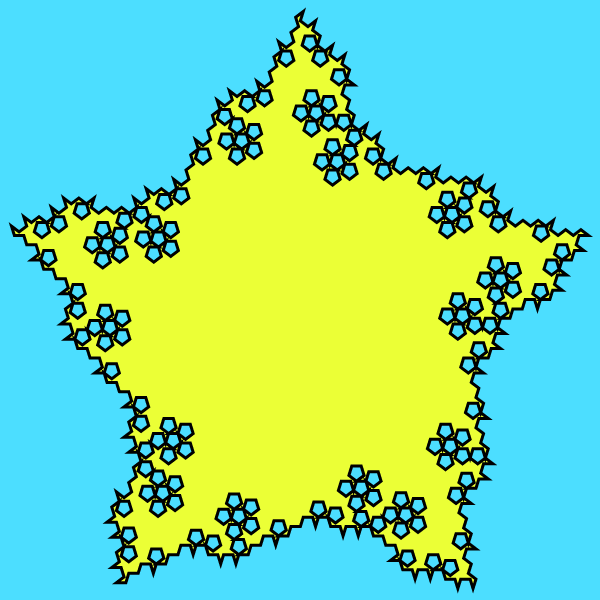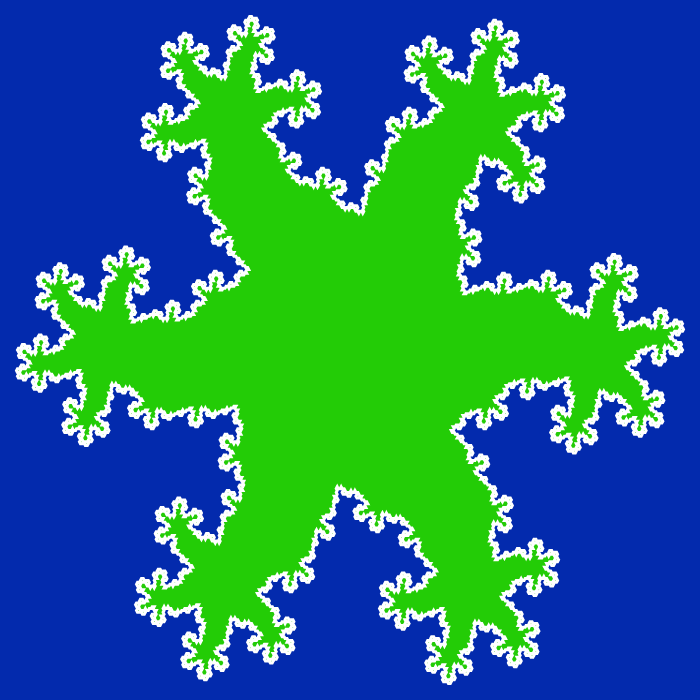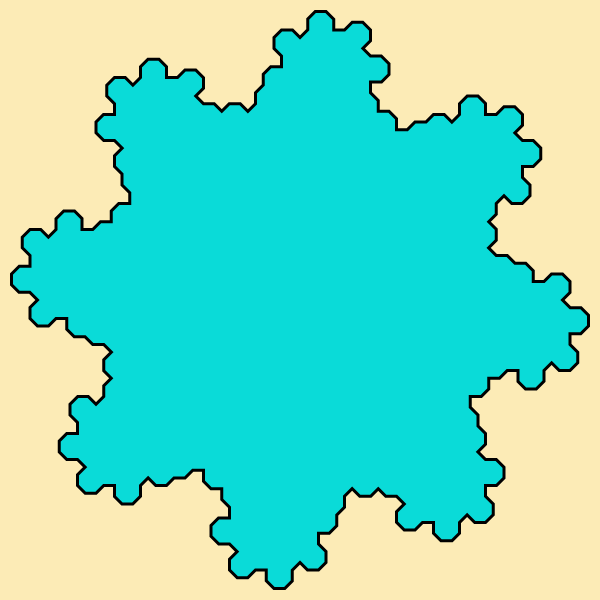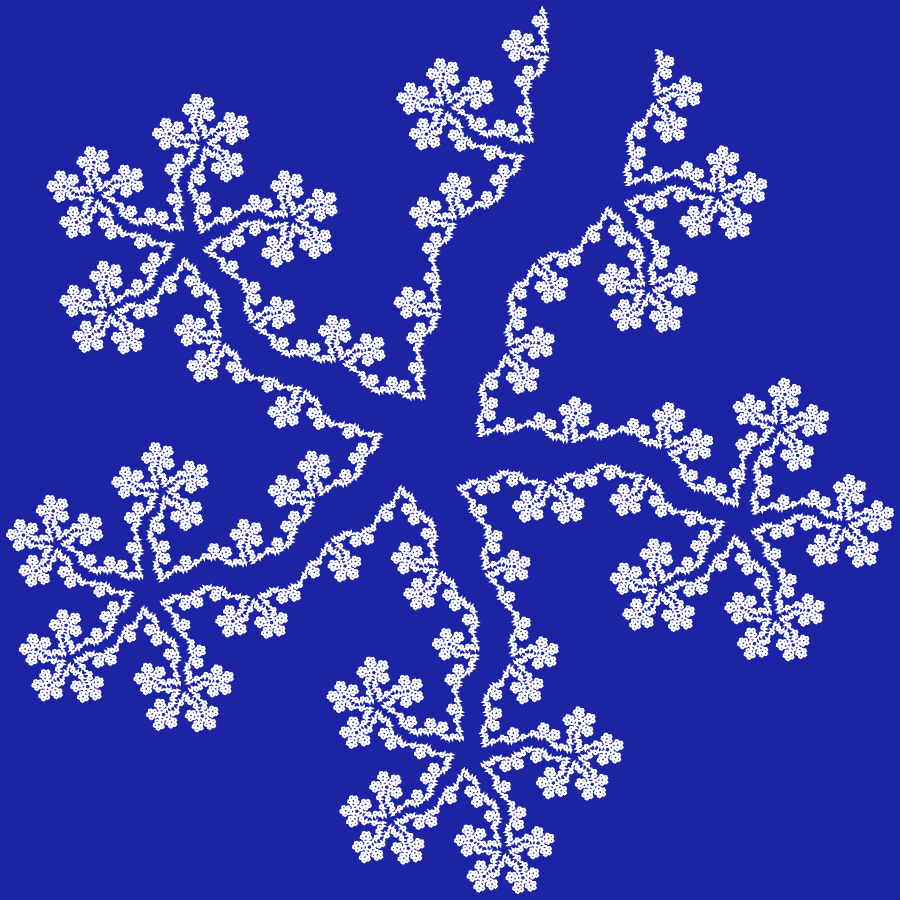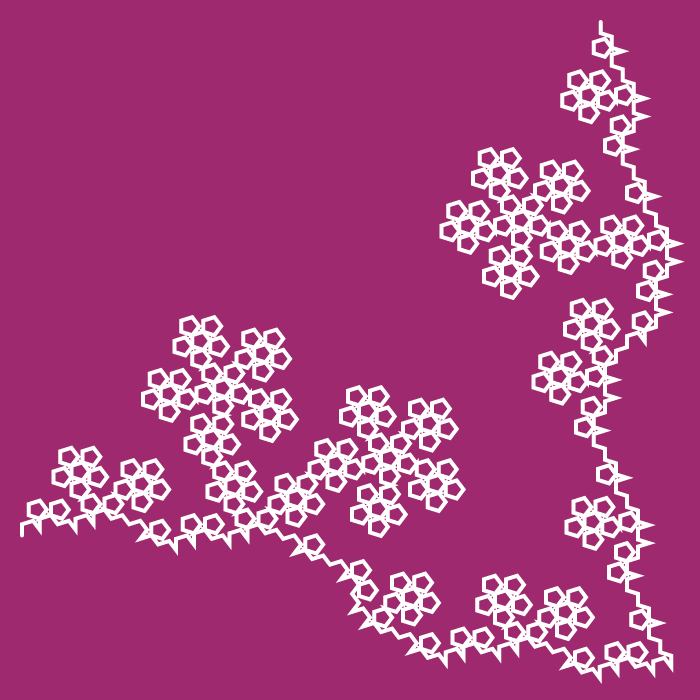This utility lets you draw your own original McWorter dendrite fractals. You can choose between four dendrite types – pentadendrite, hexadendrite, octadendrite and a single dendrite branch. There are also two extra drawing modes available – the starfish fractal mode and open fractal mode that create even more possibilities (see description below for more details). You can adjust the size and color of the drawing canvas and set its padding. You can also adjust the number of iterations, choose the rotation of the fractal (clockwise or counterclockwise), and its direction (right, left, up or down). Finally, you can choose the thickness of the fractal curve, adjust its color, and fill the inside of the fractal with any color. Fun fact – the McWorter fractal consists of a set of six-fold zigzags that don't overlap and have a 5-fold symmetry. Created by fractal fans from team Browserling. Fractabulous!
This utility lets you draw your own original McWorter dendrite fractals. You can choose between four dendrite types – pentadendrite, hexadendrite, octadendrite and a single dendrite branch. There are also two extra drawing modes available – the starfish fractal mode and open fractal mode that create even more possibilities (see description below for more details). You can adjust the size and color of the drawing canvas and set its padding. You can also adjust the number of iterations, choose the rotation of the fractal (clockwise or counterclockwise), and its direction (right, left, up or down). Finally, you can choose the thickness of the fractal curve, adjust its color, and fill the inside of the fractal with any color. Fun fact – the McWorter fractal consists of a set of six-fold zigzags that don't overlap and have a 5-fold symmetry. Created by fractal fans from team Browserling. Fractabulous!

This online browser-based tool creates unique and colorful McWorter dendrite fractals. The McWorter dendrite fractals are a family of symmetric and self-similar fractals that consists of dendrite subfractals. The dendrite curve is a variation of McWorter's pentigree (short for pentagon filigree). It's constructed from a zig-zag of six segments, which are bent at angles of 72, 72, 144 (2x72), 72, and 72 degrees. The fractal starts with a unit segment and with each step, each segment is replaced with this zigzag. If this process is repeatedly iterated, then a dendrite fractal is formed. McWorter's pentadendrite is formed by sequentially connecting five copies of the dendrite curve that are pointing outside the pentagon. Similarly, the hexadendrite and octadendrite are a connection of six and eight dendrites. Dendrites can also be connected in such a way that they point inside the polygon. This case is illustrated if the "Starfish Mode" option is enabled. This mode reverses the direction of dendrite fibers and creates a starfish fractal. The "Open Mode" cuts the fractal open and creates a gap between the dendrites. This fractal (just like many others) was discovered by accident by William A. McWorter as he was experimenting with a BASIC program that generates dragon curves. Mind blowing and ingenious at the same time, or as we love to say – fractabulous!
This online browser-based tool creates unique and colorful McWorter dendrite fractals. The McWorter dendrite fractals are a family of symmetric and self-similar fractals that consists of dendrite subfractals. The dendrite curve is a variation of McWorter's pentigree (short for pentagon filigree). It's constructed from a zig-zag of six segments, which are bent at angles of 72, 72, 144 (2x72), 72, and 72 degrees. The fractal starts with a unit segment and with each step, each segment is replaced with this zigzag. If this process is repeatedly iterated, then a dendrite fractal is formed. McWorter's pentadendrite is formed by sequentially connecting five copies of the dendrite curve that are pointing outside the pentagon. Similarly, the hexadendrite and octadendrite are a connection of six and eight dendrites. Dendrites can also be connected in such a way that they point inside the polygon. This case is illustrated if the "Starfish Mode" option is enabled. This mode reverses the direction of dendrite fibers and creates a starfish fractal. The "Open Mode" cuts the fractal open and creates a gap between the dendrites. This fractal (just like many others) was discovered by accident by William A. McWorter as he was experimenting with a BASIC program that generates dragon curves. Mind blowing and ingenious at the same time, or as we love to say – fractabulous!
In this example, we generate the McWorter's pentadentrite fractal, which is created from five touching dendrites pointing outside the pentagon. We set the rotation of the fractal to counterclockwise and generate the fifth iteration step on a Koamaru deep blue color canvas of 600 by 600 pixels.
This example applies the "Starfish Mode" to the pentadentrite fractal. In this case, all five dendrites point inside the pentagon and as a result, we get a fractal that is very similar to a starfish! We draw a 4th order curve on a Malibu color canvas, using a black line and golden-fizz color fill.
In this example, we generate a hexadendrite fractal and make the dendrites grow outside the hexagon. As there the hexagon has six sides, the dendrites are much more spread apart and the space that is formed inside the fractal is shaped like gecko lizard's fingers. We draw 5 iterations on a Klein-blue color background and fill gecko's paws with a Harlequin-green color.
It this example, we draw three clockwise recursions of an octadendrite fractal on a 600x600px canvas with 10px padding. This fractal consists of eight dendrite fibers that connect at an angle of 45 degrees. This construction makes it look a bit similar to the Koch snowflake fractal.
In this example, we apply the "Open Mode" to the pentadendrite fractal. As a result, we get a 15-degree opening between the first and last dendrites. In this drawing mode, the fractal can't be filled as it's not connected.
This example shows an individual dendrite subfractal fiber at its 5th iteration that all other fractals are made out of. At 72 degrees it has 5-fold symmetry creates a pentadentrite, at 60 degrees it has 6-fold symmetry and creates a hexadentrite and at 45 degrees it has 8-fold symmetry and creates an octadentrite. It also has several other symmetries that are less interesting.
You can pass options to this tool using their codes as query arguments and it will automatically compute output. To get the code of an option, just hover over its icon. Here's how to type it in your browser's address bar. Click to try!
Walk the Hilbert fractal and enumerate its coordinates.
Walk the Peano fractal and enumerate its coordinates.
Walk the Moore fractal and enumerate its coordinates.
Encode the Hilbert fractal as a string.
Encode the Peano fractal as a string.
Encode the Moore fractal as a string.
Encode the Cantor set as a string.
Encode the Heighway Dragon as a string.
Encode the Sierpinski fractal as a string.
Generate a Sierpinski tetrahedron (tetrix) fractal.
Generate a Cantor's cube fractal.
Generate a Sierpinski-Menger fractal.
Generate a Jerusalem cube fractal.
Generate a Jeaninne Mosely fractal.
Generate a Mandelbrot tree fractal.
Generate a Barnsley's tree fractal.
Generate a Barnsley's fern fractal.
Generate a binary tree fractal.
Generate a ternary tree fractal.
Generate a dragon tree fractal.
Generate a de Rham curve.
Generate a Takagi-Landsberg fractal curve.
Generate a Peano pentagon fractal curve.
Generate a tridendrite fractal curve.
Generate a Pentigree fractal curve.
Generate a lucky seven fractal curve.
Generate an Eisenstein fractions fractal curve.
Generate a Bagula double five fractal curve.
Generate a Julia fractal set.
Generate a Mandelbrot fractal set.
Generate a Mandelbulb fractal.
Generate a Mandelbox fractal.
Generate a Buddhabrot fractal.
Generate a Burning Ship fractal.
Generate a toothpick sequence fractal.
Generate an Ulam-Warburton fractal curve.
Generate an ASCII fractal.
Generate an ANSI fractal.
Generate a Unicode fractal.
Generate an emoji fractal.
Generate a braille code fractal.
Generate a fractal in audio form.
Create a fractal that looks like one but isn't a fractal.
Generate a fractal from any text.
Generate a fractal from a string.
Generate a fractal from a number.
Join any two fractals together.
Create a completely random fractal.
Set up an arbitrary IFS system and iterate it.
Recursively transform an image using IFS rules.
Run infinite compositions of analytic functions.
Create a surface that mimics a natural terrain.
Create a fractal surface via Brownian motion.
Apply fractal algorithms on your image and make it self-similar.
Find fractal patterns in any given image.
Find fractal patterns in any given text.
Find fractal patterns in any given number.
Tessellate a plane with fractals.
Run a cellular automaton with custom rules.
Play Conway's Game of Life on an infinite grid.
Subscribe to our updates. We'll let you know when we release new tools, features, and organize online workshops.
Enter your email here
We're Browserling — a friendly and fun cross-browser testing company powered by alien technology. At Browserling our mission is to make people's lives easier, so we created this collection of fractal tools. Our tools have the simplest user interface that doesn't require advanced computer skills and they are used by millions of people every month. Our fractal tools are actually powered by our web developer tools that we created over the last couple of years. Check them out!

